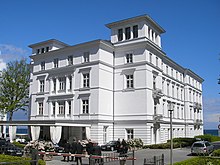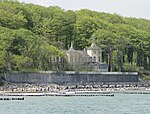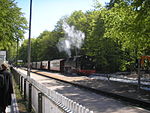Heiligendamm
Heiligendamm | |
|---|---|
Ortsteil of Bad Doberan | |
 Seebrücke (pier) towards Heiligendamm spa | |
| Coordinates: 54°09′00″N 11°50′00″E / 54.15000°N 11.83333°E | |
| Country | Germany |
| State | Mecklenburg-Vorpommern |
| District | Rostock |
| Town | Bad Doberan |
| Founded | 1793 |
| Elevation | 3 m (10 ft) |
| Population (2020)[1] | |
| • Total | 175 |
| Time zone | UTC+01:00 (CET) |
| • Summer (DST) | UTC+02:00 (CEST) |
| Postal codes | 18209 |
| Dialling codes | 038203 |
| Vehicle registration | LRO |
| Website | Official website |
Heiligendamm (German pronunciation: [ˈhaɪlɪɡəndam]) is a German seaside resort founded in 1793.
It is the oldest seaside spa in continental Europe. Heiligendamm is part of the town Bad Doberan in the state of Mecklenburg-Vorpommern and historically belongs to Mecklenburg.
The cluster of resort architecture mansions and spa buildings at the seafront are reminders of the glory days when this part of the Baltic Sea was one of the playgrounds of Europe's aristocracy.[2] Due to the classicist white buildings lining the beach promenade, the town is also known as the "White Pearl" (German: Weiße Perle) or the "White Town by the Sea" (German: Die weiße Stadt am Meer).
Today, the area by the sea is occupied by a five-star hotel, the
History


Heiligendamm was developed as an elegant meeting place for the nobility and high society. Among its most prominent guests were the German Emperors.
Its founder and first guest in 1793 was the
After the

A new company, the
On July 13, 2006, United States President George W. Bush stayed at Heiligendamm while on a state visit to see German Chancellor Angela Merkel in Stralsund.
On June 6 to 8, 2007, Heiligendamm's
In July 2013, the Grand Hotel Heiligendamm was bought by
Sights

The resort architecture near the beaches of Heiligendamm, consisting of classicist and historicist mansions and spa buildings, is part of a unique heritage, as the first such buildings of the European continent can be seen here. The area of the Grand Hotel is partly accessible to visitors, but should be experienced respectfully to not disturb the hotel guests.
The narrow gauge railway known as
Heiligendamm also has a 200-metre-long pier into the Baltic Sea that allows great views of the White Pearl Mansions at the beach.[5]
Images
-
Foundation memorial stone
-
The Kurhaus, earliest example of resort architecture, part of the Grand Hotel Heiligendamm
-
Beach villas at Heiligendamm, the so-called Perlenkette.
-
Reconstructed Villa Perle in 2013 (formerly demolished in 2007 for the G8 summit)
-
Alexandrinen-Cottage, a noble mansion next to the Grand Hotel
-
The narrow gauge line Bäderbahn Molli in Heiligendamm station
-
Catholic forest chapel of 1888
Literature
- in English language
- Charles James Apperley: "Nimrods German Tour" – a travel through northern Germany, especially to Heiligendamm in 1828. Publishing company: ISBN 978-3-939198-70-3
- in German language
- Hans Thielcke: Die Bauten des Seebades Doberan - Heiligendamm um 1800 und Ihr Baumeister Severin. Godewind Verlag, 2004 ISBN 978-3-938347-90-4. (Reprint d. Originalausgabe von 1917)
- Friedrich Compart: Geschichte des Klosters Doberan. Godewind Verlag, 2004. ISBN 978-3-938347-07-2. (Reprint der Originalausgabe von 1872)
- Heinrich Hesse: Die Geschichte von Doberan-Heiligendamm. Godewind Verlag, Wismar 2004, ISBN 978-3-938347-09-6. (Bearbeitete Neuauflage der Originalausgabe von 1838)
- Adolf Nizze: Doberan-Heiligendamm: Geschichte des ersten deutschen Seebades. Godewind Verlag, Wismar 2004, ISBN 978-3-938347-23-2. (Bearbeitete Neuauflage der Originalausgabe von 1823)
- Die Reise eines Gesunden in die Seebäder Swinemünde, Putbus und Doberan. Godewind Verlag, Wismar 2005, ISBN 978-3-938347-73-7. (Bearbeitete Neuauflage der Originalausgabe von 1823)
- Hans-Jürgen Herbst: Kalender 2007, Doberan & Heiligendamm, erstes deutsches Seebad. Godewind Verlag, 2007, ISBN 978-3-938347-57-7.
- Samuel G. Vogel: Allgemeine Baderegeln zum Gebrauche für Badelustige überhaupt und diejenigen insbesondere, welche sich des Seebades in Doberan bedienen. Godewind Verlag, 2004, ISBN 978-3-938347-88-1. (Bearbeitete Neuauflage der Originalausgabe von 1817)
See also
References
- ^ "Daten & Fakten". Stadt Bad Doberan. Retrieved 27 September 2021.
- ^ a b Bradley, Kimberly. "A Spa Town Reclaims Its Glory," New York Times. June 3, 2007.
- ^ "An Orgy of Violence as G8 Approaches; German City Rocked by Violent Riots," Der Spiegel. June 2, 2007.
- ^ Luxury hotel bought by accountant (Der Spiegel, German)
- ^ Ostsee-Zeitung: Seebrücke in Heiligendamm wieder begehbar
External links
- Heiligendamm official website (in German)









